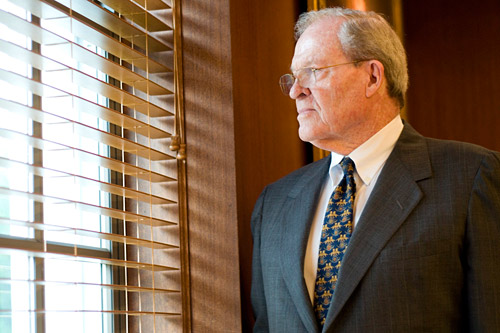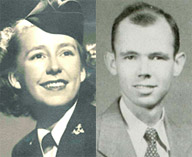Autumn 2009: Of Note

VisionARY: As Emory’s president during the transformative period after the Woodruff gift, James Laney expanded the University’s doctoral-level programs in scope and reputation.
Bryan Meltz
Laney’s Legacy
Graduate School named for President Emeritus James Laney

Who is this promising young couple?
The late Mary Jean Craft Johnston 48M 50PhD, of Elberton, Georgia, was the second woman to receive a doctoral degree from the University and the first woman to receive a PhD in chemistry from Emory. Prior to earning her advanced degrees, she served in the U.S. Navy. Afterward, she worked for a chemical company in Alabama. In 1953, she married Thomas Johnston 48PhD, the first-ever recipient of a doctorate from Emory, also in chemistry. He joined the staff of the Southern Research Institute in Birmingham where he became section head in 1958. His work was in the area of organic sulfur chemistry and the synthesis of potential anticancer and antiradiation drugs. —Mary J. Loftus
By Elaine Justice
The goal was to grant at least one hundred doctorates a year.
When James T. Laney became president of Emory in 1977, he came to the conclusion that for Emory to emerge in the front ranks of universities, it must have a much larger faculty in arts and sciences and much stronger graduate programs across the board.
“The departments, in many cases with few exceptions, were not large enough or deep enough to sustain a first-class graduate program,” he says. “I felt no distinguished program could keep its head up if it didn’t grant a hundred PhDs.”
During the next decade, with the help of the $105 million Woodruff gift in 1979, Laney focused on growing the faculty, attracting distinguished scholars through initiatives such as Woodruff professorships, raising the enrollment of Emory College, and expanding the graduate program “in distinction and sheer breadth.”
The Graduate School now offers degrees in forty-one programs across the humanities, social sciences, biomedical and natural sciences, public health, nursing, and business, with roughly 1,700 students enrolled in these programs. Emory’s graduate faculty now number more than 650. And hundreds of PhD students graduate each year.
Soon, they will graduate from a school that bears Laney’s name.
The Emory University Board of Trustees has approved naming the Graduate School in honor of President Emeritus Laney, who led the University for sixteen years, during which time it emerged as a national research university. After leaving the Emory presidency in 1993, he became the U.S. ambassador to South Korea.
“The naming of the James T. Laney School of Graduate Studies honors the vision and leadership of Jim Laney, whose ambitious plan for Emory revolved around graduate education,” says President James Wagner. “He understood clearly that the core of great research universities lies in the training of new generations of intellectual leaders for the academy and for the public good.”
“Emory’s decision to name the Graduate School for me is the greatest honor of my life,” says Laney. “From the very first, Emory has been in my heart, and I am deeply touched and humbled to always be associated with the University in such a special way.”
Lisa Tedesco, dean of the newly named Laney Graduate School, says it is “a fitting way to acknowledge President Laney because it recognizes his vision for the central role of doctoral education in establishing and sustaining a great research university at the forefront of discovery in the sciences and humanities.”
“Under Laney’s leadership, Emory embarked on an extraordinary transformation, guided by goals he outlined in his ‘Emory 2000’ address, delivered in 1987,” Tedesco says. “It was a transformation of the very identity of Emory.”
After all, Emory didn’t grant a PhD until nearly the 1950s, Laney says. “We’re a young university when it comes to graduate education at the doctoral level.”
In 1979, barely two years into Laney’s presidency, Emory received the gift of $105 million in Coca-Cola stock from the Emily and Ernest Woodruff Foundation. “There’s no way to overestimate what the Woodruff gift did for Emory,” Laney says. “The Graduate School was as much as any other part of the University a recipient of that strength.”
During the next decade, the Graduate School flourished. The size of the gift, the widespread publicity, and the University’s vision for building its strengths in graduate education meant that Emory was able to attract a number of distinguished scholars. “They saw a future here,” says Laney.
An ordained United Methodist minister, Laney taught at Yonsei University in Korea and Vanderbilt University before becoming dean of Candler School of Theology from 1969 to 1977. Laney served as U.S. ambassador to South Korea from 1993 to 1997 and was instrumental in helping defuse the nuclear crisis with North Korea in 1994.